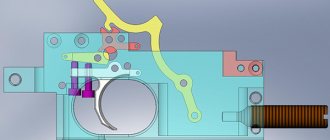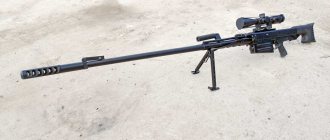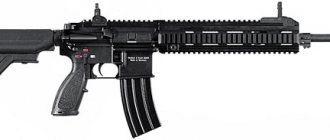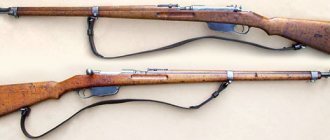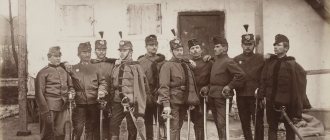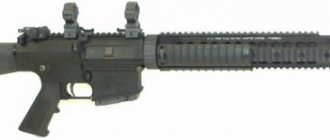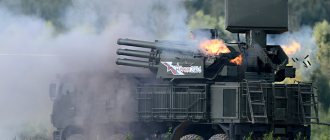2 595
The Austrian Armed Forces have received a new 8.6 mm medium sniper rifle. It complements the range of precision small arms of the Austrian army. The new rifle has a larger caliber and a more powerful scope than the well-known SSG 69 sniper rifle. In 2022, the 8.6 mm rifle began to be supplied to the troops.
In 1969, the Austrian company Steyr Mannlicher developed the SSG 69 sniper rifle, which then entered service with the Austrian ground forces as a sniper weapon. Over the half century since the introduction of SSG 69 in weapons technology, as well as optics, numerous developments have appeared that provide greater accuracy. Thus, the sight is “thinner” (crosshair, etc.), and the magnification factor of the optics is higher than that of the SSG 69. The weapon has become modular and is adjusted to the shooter using an adjustable stock and other components.
Another aspect that is increasingly coming to the fore is firing range. The new 8.6 mm Steyr 08A2 medium sniper rifle (mSSG), also designated Steyr MSSG M1 for civilian use, increases the firing range compared to the SSG 69 from 800 m to 1200 m (plus 50 percent).
Medium sniper rifle mSSG
Characteristics of the AUG Steyr assault rifle
| A country: | Austria |
| Type: | Assault rifle |
| Date of issue: | 1977 |
| Caliber: | 5.56 mm/9 mm (automatic/submachine gun) |
| Length: | 790 mm (508 mm barrel) |
| Weight: | 3.6 kg (curb) |
| Rate of fire: | 650/750 rounds per minute (automatic/submachine gun) |
| Initial bullet speed: | 992 m/s, sighting range: 650 m |
| Ammunition: | 9,30,42 rounds of 5.56x45 mm NATO standard (automatic), 25 rounds of 9x19 mm (submachine gun) |
Characteristics are given for modification AUG A2
“AUG Steyr assault rifle (“Sturmgewehr-77”) - capabilities, history of creation, design features and modifications”
Device
The rifle's bolt consists of a cylindrical central part equipped with a pair of guides. At the front end of the bolt there is a working shank equipped with two lugs. On the surface of the central part there are spiral guides, which automatically rotate the working shank along with the stops during the rectilinear movement of the bolt.
The design simplified the process of working with the bolt and increased the rate of fire.
At the same time, the effort required to operate the shutter increased and the reliability of the unit decreased.
On the side of the rear of the receiver there is a manual safety catch of the flag type. To turn it on, the lever turns upward, engages with the bolt and blocks its movement. In this case, the striker is additionally retracted a certain distance back. The fuse is turned off by moving the flag down all the way.
To load the magazine, a stamped thin-walled steel pack of 5 rounds is used. The cartridges in the pack are located offset, the bottom of the upper cartridge case is located in front of the bottom of the lower case. This arrangement ensures that cartridges are fed into the chamber without jamming. The pack is not symmetrical, it is inserted only on one side.
There is a groove on the top of the pack that allows you to determine the installation position. If necessary, cartridges are removed from the magazine along with the pack. To do this, there is a locking button on the front of the trigger guard. Pressing it when the shutter is open allows you to remove the pack, which is pushed up by the feeder.
The trunk is round in shape, with a cross-section of variable length. The minimum cross-section is located closer to the muzzle. The barrel shank has a thread that is used to connect to the box. The connection is made with tension.
The barrel bore is equipped with four rifling directed from left to top to right.
The barrel box is equipped with a channel intended for installing the bolt. The back of the box is equipped with a reinforcing jumper.
The frame sight is located on a base mounted on the barrel. The connection is soldered to ensure immobility. The sight is equipped with graduations measured in Austrian “steps” (75 cm each). The maximum adjustment of the sight is 2600 steps.
It is possible to aim with the frame lowered; in this case, the sight has a slot set to a distance of 500 steps. The minimum aiming distance with the frame raised is 300 steps. Rifles with the ability to install an optical sight were produced in small batches.
The rifle was equipped with a blade-type bayonet, which was attached to the barrel and the front stock ring. When traveling, the bayonet was worn in a sheath. To clean the bore in the field, a rope-type wipe (so-called “beads”) is used. There is no standard cleaning rod. The wooden stock is equipped with a semi-pistol type neck.
An additional cover is installed to cover the barrel of the weapon. The pad protects your hands from the barrel heated during shooting. For carrying, a belt attached to two swivels is used. One swivel is located on the butt, the second is on the central ring.
The history of the creation of the AUG Steyr assault rifle (“Sturmgewehr-77”)
The Steyr rifle AUG (Armee Universal Gewehr - army universal rifle) was developed specifically for the Austrian army, and was put into service back in 1978, but still stands out in the range of weapons both for its unusual appearance and combat qualities.
I must say that before the release of AUG, I was not involved in military weapons at all, specializing in sporting rifles. However, she approached the matter of creating a combat assault rifle very thoroughly and seriously.
The “versatility” of the weapon lies primarily in the fact that you can choose the barrel length: 621 mm for use as a light machine gun, 508 mm for a rifle, 407 mm for a carbine. And 350 mm for a submachine gun. To do this, there is no need to take the rifle to the workshop; all transformations can be performed on the battlefield, if the necessary components are available.
Due to the modular design, the AUG Steyr rifle can be turned into such a “monster”
The receiver with the optical sight is also made as a “module”; it can be replaced with another, in which the mount for the sight is made in accordance with NATO standards.
The Steyr case material is composite, lightweight, but at the same time very durable. In a special demonstration, the rifle's receiver was not damaged even after a 6-ton truck was driven over it. There, the reliability of the machine gun as a whole was clearly demonstrated - it was filled with mud, fired with a barrel filled with water, etc., and the AUG passed all tests with honor.
Currently, the AUG "Steyr" is in service in more than 30 countries around the world. However, after 30 years of use, it has not become a mass weapon, and is unlikely to ever become. The fact is that in the basic configuration the AUG is designed almost exclusively for firing at a range of up to 300 meters by small tactical groups in difficult urban conditions. This (as well as the high price) a priori makes it a weapon exclusively for special forces.
Steyr AUG HBAR-T tactical support rifle with extended barrel and bipod
Development and procurement
The mSSG Steyr 08A2 sniper rifle was purchased for the Austrian Army based on the results of a two-stage international competition. At the first stage, eleven manufacturers showed interest. At the second stage, four applicants remained, of which two are from Austria and two from the European Union. The competition was won by the Austrian company Steyr Arms (formerly Steyr Mannlicher).
However, not only the rifle is of Austrian origin, but also the sight - which is an important component of the sniper system - manufactured by KAHLES K624i. Like the rifle, it is one of the most powerful scopes on the international market. According to publications, it currently offers the only system in the world with the ability to install optics on the left side without using the shooter's right hand.
The selection of components such as weapons, sights or muzzle brakes is closely coordinated with the snipers of the Special Forces Command (Jagdkommando) of the Austrian Armed Forces. As a result, this system is considered to be the product that best suits the desires of snipers and offers high field suitability. In total, 120 sets of this weapon system will be purchased for the Austrian Armed Forces for an amount of about 1.6 million euros. The entire tranche is planned to be transferred to sniper units and groups of infantry battalions and the Special Forces Command. Weapon systems come with an extensive range of accessories.
Design of the AUG Steyr assault rifle (“Sturmgewehr-77”)
The Austrian assault rifle AUG Steyr is an automatic weapon that operates on the principle of removing powder gases, with a magazine feed, air-cooled interchangeable barrel, and a bullpup layout.
The plastic body of the rifle houses the trigger rod, safety and trigger mechanism. The latter is assembled together so that when disassembled it forms a single module. The receiver is equipped with protrusions for mounting in the front part of the barrel, and in the rear for the bolt. It also contains a gas tube cylinder to the right of the barrel, and a cylinder for the bolt handle rod to the left.
Steyr AUG as a submachine gun. Please note - as befits a submachine gun, this “steyr” is equipped with a magazine with 9 mm cartridges
The bolt carrier moves along two guide rods that fit into these cylinders and house the return springs. The bolt is rotated and locked using a pin that fits into a shaped cutout in the bolt frame. The bolt carrier and bolt are housed in a plastic stock and are held in place with a conventional latch.
Then the barrel is inserted into the receiver, which snaps into the walls of the receiver. The plastic striker inserts through the rear of the stock and is held in place by the buttplate. Above the receiver there is a carrying handle in which a 1.4x optical sight is mounted. The double-row detachable plastic magazine holds 30 rounds.
Since the rifle has only one sight, the new soldier does not have to try to line up the target, front sight and sight slot to get an accurate shot. Thus, learning to shoot this rifle does not take much time.
Picatinny rails allow you to very quickly re-equip the Steyr AUG rifle with suitable “body kits” - changing the sight, replacing the flashlight with a grenade launcher, all this is done in a matter of minutes
The AUG Steyr is supplied with ammunition from double-row box magazines made of impact-resistant plastic, with side inserts made of transparent polymer, for visual control of the amount of ammunition in the magazine. Magazine capacity: 9, 30 and 42 rounds. The magazine release is located behind the magazine well and is equally accessible for right and left hands.
Modifications of the AUG Steyr assault rifle
- Steyr AUG A1 - base model from 1977. It features a non-removable fixed vertical front handle and a built-in low-power optical sight in the carrying handle.
- Steyr AUG A2 - differs from the A1 in its universal mount for NATO standard sights and a folding front handle.
- Steyr AUG A3 - differs from the A1 by the presence of 4 Picatinny rails: for sights (upper), under-barrel grenade launcher (lower) and 2 side ones for a laser designator, etc. equipment.
- Steyr AUG Z is a civilian self-loading version of the AUG A2.
- Steyr AUG HBAR-T is a tactical support rifle (for infantry sniper) of 5.56 mm caliber, with a longer and heavier barrel.
- Steyr AUG LMG is a 5.56 mm light machine gun based on the HBAR-T.
Source: compilation based on publicly available information on the Internet
Medium Sniper Rifle: Caliber
At the international level, there is a transition from the previously used 7.62x51 mm NATO (.308) ammunition to 8.6x70 mm Lapua (.338). The Lapua Magnum caliber 8.6x70 mm is characterized by minimal deflection and braking from wind and air resistance. Ammunition of this caliber is distinguished by very precise manufacturing, which at long distances allows for a smaller dispersion circle. Candidate snipers, when shooting from the new mSSG 08A2, already during the acceptance tests, in order to gain access to training, achieve a scattering circle diameter of a maximum of three centimeters per 100 m.
Comparison of calibers 7.62 and 8.6 mm
Currently, the 8.6x70 mm Lapua Magnum caliber is actively used by operational units around the world for “long ranges” (more than 1000 m). In addition, there is a wide range of ammunition types available in this caliber used internationally: armour-piercing, glass-piercing or full-jacketed. Having a choice of ammunition allows the sniper to be more successful in a variety of scenarios.
Assembly and disassembly
There are several options for disassembling the Mannlicher rifle, which differ in purpose. After firing, partial disassembly is used, consisting of two steps:
- Separate the bayonet. To do this, place the rifle butt on the ground, release the latch and move the bayonet upward.
- Place the weapon on a flat surface and open the bolt. Then push the trigger forward with the finger of one hand and remove the bolt from the box channel with the other hand.
After cleaning, the bolt is inserted into place, the hook is pulled forward and the bolt is pushed into the box until it stops. After this, a smooth descent is performed. To do this, press the trigger and at the same time hold the trigger comb with your finger.
The bolt part can be disassembled to replace worn elements and clean. At the same time, the trigger, working shank and firing pin are separated from it. To remove moisture, disassembly is used to separate the barrel and box from the stock. It is possible to remove the magazine box, which is used to clean dirt, remove thickened grease and replace parts.
